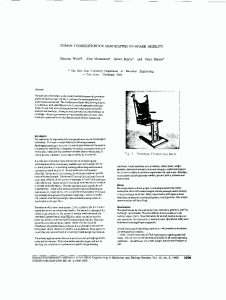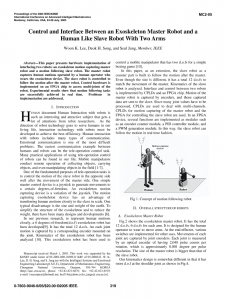Архив категории Ищем научные статьи
Human Exoskeleton For Handicapped On-board Mobility
- Тип контента: Научная статья
- Номер документа: 945
- Название документа: Human Exoskeleton For Handicapped On-board Mobility
- Номер (DOI, IBSN, Патент): 10.1109/IEMBS.1990.692300
- Изобретатель/автор: Weed, H., Sikora, P., Mortensen, A., Hayes, J.
- Правопреемник/учебное заведение: The Ohio State University
- Дата публикации документа: 2002-08-06
- Страна опубликовавшая документ: США
- Язык документа: Английский
- Наименование изделия: Не заполнено
- Источник: http://ieeexplore.ieee.org/search/freesrchabstract.jsp?tp=&a
- Вложения: Не заполнено
- Аналитик: Не заполнено
Категория: Ищем научные статьи | Нет комментариев »
Control and Interface between an Exoskeleton Master Robot and a Human Like Slave Robot with Two Arm
- Тип контента: Научная статья
- Номер документа: 938
- Название документа: Control and Interface between an Exoskeleton Master Robot and a Human Like Slave Robot with Two Arm
- Номер (DOI, IBSN, Патент): 10.1109/AIM.2005.1501010
- Изобретатель/автор: Woon Kyu Lee, Seul Jung, Deok Hee Song
- Правопреемник/учебное заведение: Не заполнено
- Дата публикации документа: 2005-09-26
- Страна опубликовавшая документ: Не заполнено
- Язык документа: Английский
- Наименование изделия: Не заполнено
- Источник: http://ieeexplore.ieee.org/search/freesrchabstract.jsp?tp=&a
- Вложения: Не заполнено
- Аналитик: Не заполнено
Категория: Ищем научные статьи | Нет комментариев »
Changing human upper-limb synergies with an exoskeleton using viscous fields
- Тип контента: Научная статья
- Номер документа: 936
- Название документа: Changing human upper-limb synergies with an exoskeleton using viscous fields
- Номер (DOI, IBSN, Патент): 10.1109/ICRA.2011.5979626
- Изобретатель/автор: Sahbani, Anis, Roby-Brami, A., Morel, G., Jarrasse, N., Crocher, V.
- Правопреемник/учебное заведение: Institute of Intelligent Systems and Robotics (CNRS - UMR 7222), University Pierre & Marie Curie, Paris, France
- Дата публикации документа: 2011-08-15
- Страна опубликовавшая документ: Франция
- Язык документа: Английский
- Наименование изделия: Не заполнено
- Источник: http://ieeexplore.ieee.org/search/freesrchabstract.jsp?tp=&a
- Вложения: Не заполнено
- Аналитик: Не заполнено
 Robotic exoskeletons can apply forces distributed on the limbs of the subject they are connected to. This offers a great potential in the field of neurorehabilitation, to address the impairment of interjoint coordination in hemiparetic stroke patients. In these patients, the normal flexible joint rotation synergies are replaced by pathological fixed patterns of rotation. In this paper, we investigate how the concept of synergy can be exploited in the control of an upper limb exoskeleton. The long term goal is to develop a device capable of changing the joint synchronization of a patient performing exercises during rehabilitation.
Robotic exoskeletons can apply forces distributed on the limbs of the subject they are connected to. This offers a great potential in the field of neurorehabilitation, to address the impairment of interjoint coordination in hemiparetic stroke patients. In these patients, the normal flexible joint rotation synergies are replaced by pathological fixed patterns of rotation. In this paper, we investigate how the concept of synergy can be exploited in the control of an upper limb exoskeleton. The long term goal is to develop a device capable of changing the joint synchronization of a patient performing exercises during rehabilitation.
Категория: Ищем научные статьи | Нет комментариев »
Comparison and evaluation of robotic strength rehabilitation algorithms: Isokinetic, isotonic and shared control method
- Тип контента: Научная статья
- Номер документа: 3556
- Название документа: Comparison and evaluation of robotic strength rehabilitation algorithms: Isokinetic, isotonic and shared control method
- Номер (DOI, IBSN, Патент): 978-1-4577-1698-0
- Изобретатель/автор: MinKi Sin, Kyu-Jin Cho, DaeGeun Park
- Правопреемник/учебное заведение: Sch. of Mech. & Aerosp. Eng., Seoul Nat. Univ., Seoul, South Korea
- Дата публикации документа: 2011-09-23
- Страна опубликовавшая документ: Корея
- Язык документа: Английский
- Наименование изделия: Не заполнено
- Источник: http://ieeexplore.ieee.org/xpl/freeabs_all.jsp?arnumber=6024
- Вложения: Нет
- Аналитик: Helix
 Strength rehabilitation is an essential treatment for the patient who has motor control disorder. However the strength rehabilitation process is a labor intensive work therefore many people have found a solution in robotics. Many studies propose various strength rehabilitation robots and control methods. It is well known that the high muscle activation during the rehabilitation process can accelerate the progress of the recovery. However there is little quantitative study about the relationship between the control parameters and the muscle activation. This paper shows how the control parameters affect the muscle activation. We use three control methods; isokinetic, isotonic and shared control, widely used control method in rehabilitation robots. With this result, we suggest a method to adjust the exercise intensity.
Strength rehabilitation is an essential treatment for the patient who has motor control disorder. However the strength rehabilitation process is a labor intensive work therefore many people have found a solution in robotics. Many studies propose various strength rehabilitation robots and control methods. It is well known that the high muscle activation during the rehabilitation process can accelerate the progress of the recovery. However there is little quantitative study about the relationship between the control parameters and the muscle activation. This paper shows how the control parameters affect the muscle activation. We use three control methods; isokinetic, isotonic and shared control, widely used control method in rehabilitation robots. With this result, we suggest a method to adjust the exercise intensity.
Категория: Ищем научные статьи | 4 комментария »
On the design of an exoskeleton for neurorehabilitation: design rules and preliminary prototype
- Тип контента: Научная статья
- Номер документа: 916
- Название документа: On the design of an exoskeleton for neurorehabilitation: design rules and preliminary prototype
- Номер (DOI, IBSN, Патент): 10.1109/IEMBS.2004.1404330
- Изобретатель/автор: Vecchi, F., Dario, P., Cattin, E.
- Правопреемник/учебное заведение: ARTS Lab., Scuola Superiore Sant' Anna, Pontedera, Italy
- Дата публикации документа: 2005-03-14
- Страна опубликовавшая документ: Италия
- Язык документа: Английский
- Наименование изделия: Не заполнено
- Источник: http://ieeexplore.ieee.org/search/freesrchabstract.jsp?tp=&a
- Вложения: Не заполнено
- Аналитик: Не заполнено
 The neurorehabilitation robotics is a promising research field that allows improvements of the therapy effects. Some interesting systems for the neurorehabilitation of the upper limb are based on standard robotic arms and their applicability and effectiveness are based on the presence of patient’s residual motor control synergy. On the other side, the exoskeletons overcome the single joint control allowing the full control of the arm kinematics. This paper presents the first results obtained at ARTS lab for the development of an exoskeleton for upper limb, starting from one of its building block that is a stand-alone active orthesis for functional assessment of the human wrist. We are addressing the design with a biomechatronic approach, based on an extensive analysis of the state-of-the-art. The design rules of sensorized wrist orthesis for functional assessment of the wrist and its first prototype are presented.
The neurorehabilitation robotics is a promising research field that allows improvements of the therapy effects. Some interesting systems for the neurorehabilitation of the upper limb are based on standard robotic arms and their applicability and effectiveness are based on the presence of patient’s residual motor control synergy. On the other side, the exoskeletons overcome the single joint control allowing the full control of the arm kinematics. This paper presents the first results obtained at ARTS lab for the development of an exoskeleton for upper limb, starting from one of its building block that is a stand-alone active orthesis for functional assessment of the human wrist. We are addressing the design with a biomechatronic approach, based on an extensive analysis of the state-of-the-art. The design rules of sensorized wrist orthesis for functional assessment of the wrist and its first prototype are presented.
Категория: Ищем научные статьи | 2 комментария »
Статистика
Категорий: 179
Статей всего: 2,003
По типу:
Видео: 36
Выдержка с форума: 1
Контактные данные: 12
Научная статья: 1388
Не заполнено: 5
Новостная статья: 317
Обзор технологии: 42
Патент: 219
Тех.подробности: 34
Тип: 1
Комментариев: 8,651
Изображений: 3,005
Подробней...
ТОР 10 аналитиков
-
Глаголева Елена - 591
Дмитрий Соловьев - 459
Helix - 218
Ридна Украина))) - 85
Наталья Черкасова - 81
max-orduan - 29
Елена Токай - 15
Роман Михайлов - 9
Мансур Жигануров - 4
Дуванова Татьяна - 3
Календарь
| Пн | Вт | Ср | Чт | Пт | Сб | Вс |
|---|---|---|---|---|---|---|
| « Ноя | ||||||
| 1 | 2 | 3 | 4 | 5 | ||
| 6 | 7 | 8 | 9 | 10 | 11 | 12 |
| 13 | 14 | 15 | 16 | 17 | 18 | 19 |
| 20 | 21 | 22 | 23 | 24 | 25 | 26 |
| 27 | 28 | 29 | 30 | 31 | ||
Авторизация
Ошибка в тексте?
Выдели её мышкой!
И нажми Ctrl+Enter



